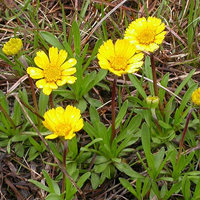Lakeside Daisy
Scientific name: Tetraneuris herbacea

Photo credit: C. D. Jones, NHIC Archives
Status
Special Concern
“Special concern” means the species lives in the wild in Ontario, is not endangered or threatened, but may become threatened or endangered due to a combination of biological characteristics and identified threats.
Date added to the Species at Risk in Ontario List
The Lakeside Daisy was already assessed as at risk when the Endangered Species Act, 2007 took effect in 2008.
Read the most recent assessment report (PDF).
What it looks like
Lakeside Daisy is a small perennial plant in the aster family that reaches up to 35 centimetres in height. Dark green, toothless leaves surround the base of the plant. They may be narrowly lance-shaped or narrow at the base and broader toward the tip like a spatula.
The plant produces one to 10 flowering stems with a single flower head per stem. The flower heads consist of bright yellow ray florets and golden yellow disk florets. Flowers bloom in early spring and are stunning against the barren rocky landscape where Lakeside Daisy grows. The seeds are scattered by the wind and gravity.
Where it lives
Lakeside Daisy is restricted to the Great Lakes region of North America, and is present in Ohio, Illinois, Michigan and southern Ontario.
Lakeside Daisy is found in grassland and pavement alvars, which are areas of exposed bedrock with very little soil. This rare habitat is kept fairly open and sunny by natural disturbances, such as drought and fire, which remove trees and shrubs that would otherwise shade-out sun-loving plants like Lakeside Daisy.
Where it’s been found in Ontario
In Ontario, it is believed Lakeside Daisy is present in 29 locations on southern Manitoulin Island (including Greene Island) and the Bruce Peninsula.
This species is globally rare but can be locally common in Ontario, where some populations consist of thousands of plants.
What threatens it
The main threats to Lakeside Daisy are:
- housing and urban areas
- mining and quarrying
- logging and wood harvesting
- recreational activities
- fire and fire suppression
- invasive species
Action we are taking
While special concern species do not receive species or habitat protection under the Endangered Species Act, 2007, the act requires us to prepare recovery guidance for special concern species, unless a recovery strategy or management plan is required for the species under the federal Species at Risk Act.
All species listed on the Species at Risk in Ontario List may be eligible for consideration for government funding through the Species at Risk Stewardship Program.
Recovery guidance
The recovery strategy and government response statement on this page were prepared for Lakeside Daisy when the species was classified on the Species at Risk in Ontario List as a threatened species.
Now that Lakeside Daisy has been reclassified as a special concern species, a recovery strategy and associated government response statement are no longer required under the Endangered Species Act, 2007. We are providing these documents here for information and reference purposes.
Recovery strategy
A recovery strategy advises the ministry on ways to ensure healthy numbers of the species return to Ontario.
Read the executive summary (May 31, 2013)
Read the recovery strategy (May 31, 2013)
Government response statement
A government response statement outlines the actions the government intends to take or support to help recover the species.
Read the government response statement (March 14, 2014)
Review of progress
A review of progress made toward protecting and recovering a species is required no later than the time specified in the species’ government response statement, or not later than five years after the government response statement is published if no time is specified.
Read the report on progress towards the protection and recovery of 16 species at risk, including Lakeside Daisy (Tetraneuris herbacea) (2019).
What you can do
Report a sighting
Submit your observations of species at risk to the Natural Heritage Information Centre (NHIC), which is Ontario’s conservation data centre. Join the centre’s Rare Species of Ontario project in iNaturalist, an online plant and animal identification app, to quickly and easily submit your observations.
Volunteer
Volunteer with your local nature club or provincial park to participate in surveys or stewardship work focused on species at risk.
Be a good steward
- Private landowners have a very important role to play in species recovery. If you find species at risk on your land, you may be eligible for stewardship programs that support the protection and recovery of species at risk and their habitats, such as the Species at Risk Stewardship Program.
- Invasive species seriously threaten many of Ontario’s species at risk. To learn what you can do to help reduce the threat of invasive species, visit:
Report illegal activity
Report any illegal activity related to plants and wildlife to
Quick facts
- The Ontario populations of Lakeside Daisy constitute about 95%of the populations existing in the world. Lakeside Daisy is one of very few plant species with most of its global range in Ontario.
- A variety of birds, mammals, and insects eat the Lakeside Daisy or its seeds, including deer and rabbits.
- The Lakeside Daisy’s thick, rubbery leaves store water, allowing it to withstand dry spells.
- On Manitoulin Island, Lakeside Daisy is also called “Manitoulin Gold”.